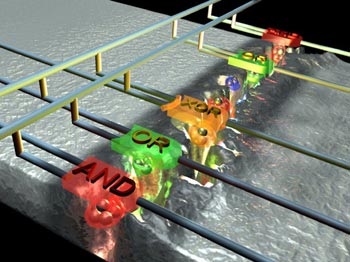Researchers at the Georgia Institute of Technology have performed logic operations with a novel optoelectronic device made of silver nanoclusters. The device built by Robert Dickson and Tae-Hee Lee operates on electronic inputs and produces an optical output that can be read without electrical contacts (T-H Lee and R M Dickson 2003 Proc. Nat. Acad. Sci. to be published)

Logic operations – such as NOT, AND and OR – are traditionally carried out by semiconductor devices, but there is a limit to how small circuits that require electrical read-outs can be made. However, devices that rely on optical output are not limited in this way.
Dickson and Lee made the nanoclusters by applying a current to a thin oxidized silver film. The current causes the migration of electrons to produce a break-junction in the sample. Arrays of nanoclusters – which consist of between two and eight silver atoms – form along this break. The researchers take advantage of the fact that these nanoclusters possess well-defined energy levels and thus emit light only when a specific voltage is applied.
The Georgia Tech team applied two separate electrical pulses to their device. The first acts as a “gate” by concentrating holes in and around the silver molecules. The second pulse, applied less than 4 nanoseconds after the first, re-injects electrons into the discrete nanocluster energy levels. The pulse combinations allow current to flow in the device. Light is emitted when electrons and holes recombine within each nanocluster after the second pulse has been applied. “By reading the emission output of two correlated molecules, we can add pulses together and perform a very simple but very important basic addition operation,” says Dickson. Applying different pulses can also cause individual clusters to operate as “on-off” logic gates with AND, OR, NOT and XOR functions.
The researchers will now attempt to make larger optoelectronic arrays by increasing the number of nanoclusters in the devices. They also hope to learn more about how the clusters form and plan to look more closely at the break-junction and its properties.




